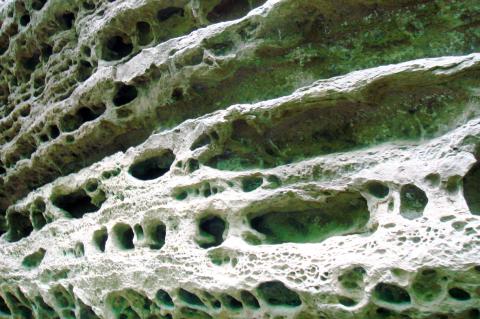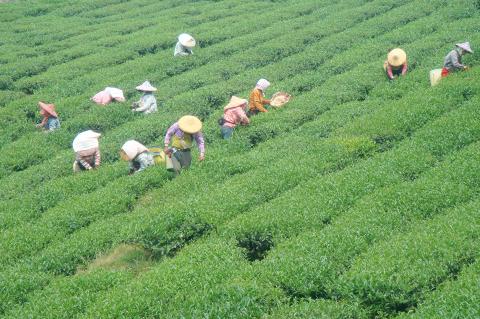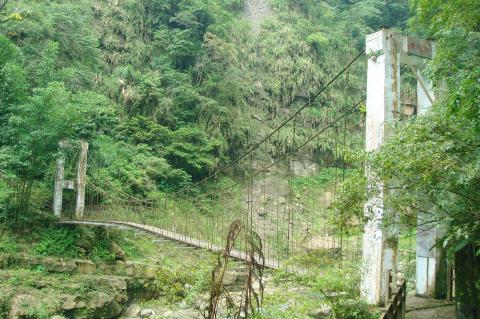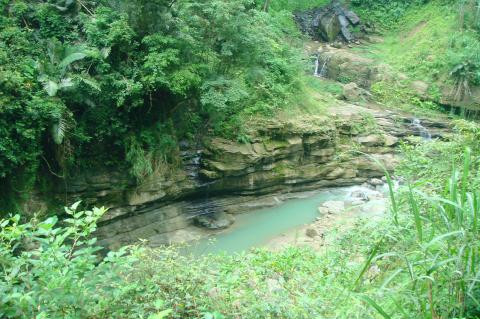Among the places badly affected by Typhoon Morakot in August 2009 was the popular travel destination of Rueili (瑞里) in the Alishan National Scenic Area (阿里山國家風景區). Roads surrounding the mountain settlement were left impassable, and the town’s tourist industry suffered as a result.
Two years on, the influence of Morakot can still be seen in a few places, but damaged roads have been cleared, repaired and rebuilt. Rueili’s attractions, especially its numerous trails, are once again pulling in visitors.
About 7km west of the town — at the 71km marker on County Highway 166 — you’ll find a car park and snack shop that mark the entrance for Yuantan Falls (圓潭瀑布). There are a couple of walking paths leading off from the rest area, and the one for the falls starts next to the shop. All the major walking paths in and around Rueili are clearly marked by signs in both Chinese and English.

Photo: Andrew Crosthwaite
The fairly steep, 500m-long path is surrounded by a dense growth of bamboo, trees and a variety of large plants. The drone of cicadas and the presence of insects jumping and flying around you are almost constant factors throughout the warm, humid summer months. Any thoughts of feeling closed in, however, are forgotten as soon as you make your way through the vegetation and emerge into an almighty, cavernous gorge.
The opposite side of the valley is marked by a towering wall of gray stone, and massive boulders and slabs of rock litter the riverbed. The falls themselves, which are located where the two sides of the valley come together, are at their best following periods of heavy rain, when the river slaps against the rock face as it plunges down in a terrific arc of water.
THE OTHER WAY

Photo: Andrew Crosthwaite
The second pathway, which starts next to the car park’s exit, leads to a pair of rock formations called Swallow Cliff (燕子崖) and Bat Grotto (蝙蝠洞). The 2km walk takes you along an historical route called Youth Ridge Trail (青年嶺步道) that continues to Rueili. The section of the path between Swallow Cliff and Rueili Elementary School in the center of the town, however, is quite steep and at the time of writing was under repair and blocked off. For the latest news on the path’s accessibility, call the Rueitai Visitor Center at (05) 250-1070.
Heading off on the second path from the car park, you’re led slowly toward a river and your first view of the cliff and grotto.
The valley here feels wonderfully remote and deserted. Vines stretch down to the riverbed from the branches of trees high on the hillside, and plants grow over the cables of a well-weathered suspension bridge.

Photo: Andrew Crosthwaite
The overall effect gives the place a lost world quality: You half expect to see pterodactyls circling the sky above you.
The 40m-wide Swallow Cliff is lined with deep grooves that used to be home to a large number of swallows’ nests. For much of the year, walking underneath it entails passing behind a curtain of water, as a stream usually flows over the cliff into the river below.
Though smaller, Bat Grotto is even more interesting as its entire surface is riddled with holes and depressions. Up close, the eroded rock resembles a wall of ancient, decaying skulls.

Photo: Andrew Crosthwaite
Half a kilometer east along County Highway 166 from the Yuantan Falls entrance — at the 71.5km marker — is the Yuantan Natural Eco Park (圓潭自然生態園區). The park was opened to the public in 2007. There’s a visitor center and cafe that overlooks a small waterfall, and there are several short walking paths. None of them are longer than a few hundred meters, and they wind their way through pleasant and well-maintained countryside toward a variety of waterfalls and a botanical garden.
It’s all nice enough, but from the obviously landscaped gardens to the freshly laid turf, there is an unmistakable feeling of newness to the park. It might take a couple of more years before it can rival Rueili’s other attractions.
Driving east toward Rueili, the one thing that stands out above all else is that the town is responsible for producing copious amounts of tea. Neat lines of tea bushes rise up the slope on one side of the road, and fall down it on the other. Rueili’s tea is reputed to be exceptionally pure and has a delicious, long-lasting sweetness that is unique to tea grown here. To taste it for yourself, just head to one of the many tea shops or producers that line the main road running through the town.

Photo: Andrew Crosthwaite
Rueili is home to a variety of firefly species, and watching the glowing little insects dance and signal to one another has become a popular activity in the town. It might rank as one of the more simple ways to spend an evening, but there’s something hypnotic and magical about seeing these tiny animal-made lights darting and weaving around in the nighttime.
Depending on the species, the fireflies emit either an orange or green light, and they can be seen most nights of the year. The best places to watch them are at Rueili Elementary School and by the Ruolan Villa (若蘭山莊), located near the 79.5km mark of the highway.
Possibly the oldest attraction in Rueili is the Rueitai Trail (瑞太步道), which dates back to the 1870s. The original path was constructed to allow goods to be transported between Rueili and Taihe (太和), and in 1931, it was replaced by an easier route to give children access to the local school.
A large section of the 80-year-old trail is still in use today, though it shouldn’t be attempted lightly. It’s a punishing up-and-down path, and while the people in the Rueitai Visitor Center might tell you that the looping round-trip will take 2 hours to complete, that’s only possible if you’re very fit. If you’re up for the challenge, though, an enjoyable walk through a tall bamboo forest awaits. The trailhead can be found at the 81km marker on County Highway 166.
Sadly, the section of the trail that leads to Taihe is closed, but this is one of only a handful of blocked paths in the area. On the whole, Rueili has recovered incredibly well from the devastation of Morakot, which is good news as this is one of the nicest places to visit in the Alishan area.
What you need to know
Getting there
Getting to Rueili is fairly easy. If you’re driving, leave Highway No. 3 at the Meishan Interchange (梅山交流道). Head into Meishan and take County Highway 162 to Taiping (太平). From there, take road 154 to Taising (太興), and then turn onto County Highway 166, which will take you all the way to Rueli.
If you’re traveling by bus, buy a ticket for Rueili at the bus station right outside the Chiayi Railway Station. The only bus in the morning leaves at 9:30am and takes you to the Meishan bus station, where you board the Rueili bus.
Where to stay
There are a few hotels and guesthouses along the main road running through the town, and there’s also a good campsite with toilets and hot showers. It’s located just off County Highway 166 at about the 75km point.
For more information, contact the Rueitai Visitor Center at the 82km marker on County Highway 166, tel: (05) 250-1070 or (05) 250-2129, or try the Yuantan Visitor Center in the Yuantan Nature Eco Park (圓潭自然生態園區), tel: (05 2502026).

Cheng Ching-hsiang (鄭青祥) turned a small triangle of concrete jammed between two old shops into a cool little bar called 9dimension. In front of the shop, a steampunk-like structure was welded by himself to serve as a booth where he prepares cocktails. “Yancheng used to be just old people,” he says, “but now young people are coming and creating the New Yancheng.” Around the corner, Yu Hsiu-jao (饒毓琇), opened Tiny Cafe. True to its name, it is the size of a cupboard and serves cold-brewed coffee. “Small shops are so special and have personality,” she says, “people come to Yancheng to find such treasures.” She

The low voter turnout for the referendum on Aug. 23 shows that many Taiwanese are apathetic about nuclear energy, but there are long-term energy stakes involved that the public needs to grasp Taiwan faces an energy trilemma: soaring AI-driven demand, pressure to cut carbon and reliance on fragile fuel imports. But the nuclear referendum on Aug. 23 showed how little this registered with voters, many of whom neither see the long game nor grasp the stakes. Volunteer referendum worker Vivian Chen (陳薇安) put it bluntly: “I’ve seen many people asking what they’re voting for when they arrive to vote. They cast their vote without even doing any research.” Imagine Taiwanese voters invited to a poker table. The bet looked simple — yes or no — yet most never showed. More than two-thirds of those

In the run-up to the referendum on re-opening Pingtung County’s Ma-anshan Nuclear Power Plant last month, the media inundated us with explainers. A favorite factoid of the international media, endlessly recycled, was that Taiwan has no energy reserves for a blockade, thus necessitating re-opening the nuclear plants. As presented by the Chinese-language CommonWealth Magazine, it runs: “According to the US Department of Commerce International Trade Administration, 97.73 percent of Taiwan’s energy is imported, and estimates are that Taiwan has only 11 days of reserves available in the event of a blockade.” This factoid is not an outright lie — that

Former Chinese Nationalist Party (KMT) chairwoman Hung Hsiu-chu’s (洪秀柱) attendance at the Chinese Communist Party’s (CPP) “Chinese People’s War of Resistance Against Japanese Aggression and the World Anti-Fascist War” parade in Beijing is infuriating, embarrassing and insulting to nearly everyone in Taiwan, and Taiwan’s friends and allies. She is also ripping off bandages and pouring salt into old wounds. In the process she managed to tie both the KMT and the Democratic Progressive Party (DPP) into uncomfortable knots. The KMT continues to honor their heroic fighters, who defended China against the invading Japanese Empire, which inflicted unimaginable horrors on the